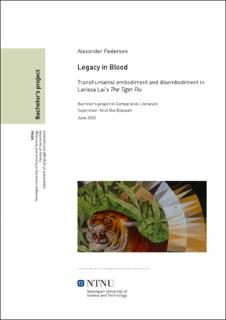| dc.contributor.advisor | Knut Ove Eliassen | |
| dc.contributor.author | Alexander Pedersen | |
| dc.date.accessioned | 2020-07-16T16:01:59Z | |
| dc.date.available | 2020-07-16T16:01:59Z | |
| dc.date.issued | 2020 | |
| dc.identifier.uri | https://hdl.handle.net/11250/2669356 | |
| dc.description.abstract | Denne oppgåva undersøkjer framsyninga av transhumanistisk kroppslegheit og ikkje-kroppslegheit i Larissa Lais roman frå 2018, The Tiger Flu, som ein kamp mellom høgre-lenande frimarknad extropianisme og radikalt kroppsleg transhumanisme. Temaa i denne undersøkinga inkluderer romanens radikale skildring av tid og historie erfart gjennom kroppslegheit, sekulær-religiøse funksjonar tent av transhumanisme, samt uttrykket og rolla dette har i romanen, samt dei utnyttande ekspansjonistiske ideala som ligg til grunne for extropianisme, og opposisjonen rørsla møter av framandgjorte figurar som omfamnar kroppslegheit. Verka teken i bruk for undersøkinga vert gjort opp av fleirfaldige omtalar av transhumanisme i sosiale og litterære sfærar, historiske tekstar, religiøse og mytologiske undersøkingar, samt omtalar av Larissa Lais tidlegare verk og eitt stykkje biletleg kunst. Denne oppgåva demonstrerer korleis The Tiger Flu diagnostiserer den extropianistiske rørsla sine mål og ideal som trekk av global frimarknadskapitalisme – trekk som fører til utnytting av den fabrikkerte andre og sjølvdestruksjon. Temaet rundt å øydelegge individuelle kroppar for å oppnå ei falsk frelse vert synt å både reflektera og samhandle med dei større historiske rørslene som romanen handterer i dei sykliske undertrykkingssystema dei vert uttrykt gjennom. Å omfamne kroppslegheit vert demonstrert som ein form for å gjere opprør mot desse systema og bryte ut av syklusen via den kroppslege erfaringa av transhumanistisk post-minne. | |
| dc.description.abstract | This thesis examines the portrayal of transhuman embodiment and disembodiment in Larissa Lai’s 2018 novel The Tiger Flu as a struggle between right-leaning free market extropianism and radically embodied transhumanism. The subjects of this examination include the novel’s radical portrayal of time and history experienced through embodiment, the secular religious functions of transhumanism and its expression and role in the novel, as well as the exploitative expansionist ideals behind extropianism and its opposition through embraced embodiment by the oppressed other. The works used for this examination are constituted from various critiques of transhumanism in social and literary spaces, historical texts, religious and mythological examinations, as well as critiques of Larissa Lai’s prior works and one piece of visual art. This thesis demonstrates The Tiger Flu’s diagnosis of the extropian movement’s goals and its ideals as inherent traits of global free-market capitalism leading to the exploitation of the manufactured other and, ultimately, self-destruction. The theme of destroying individual bodies for a false salvation are shown to reflect and interact with the larger historical movements the novel deals with, epitomised in cyclical systems of oppression. Embracing embodiment is demonstrated as a revolt against these systems and a way of breaking from the cycle through the embodied experience of transhuman post-memory. | |
| dc.publisher | NTNU | |
| dc.title | Legacy in Blood: Transhumanist embodiment and disembodiment in Larisa Lai's The Tiger Flu | |
| dc.type | Bachelor thesis | |
